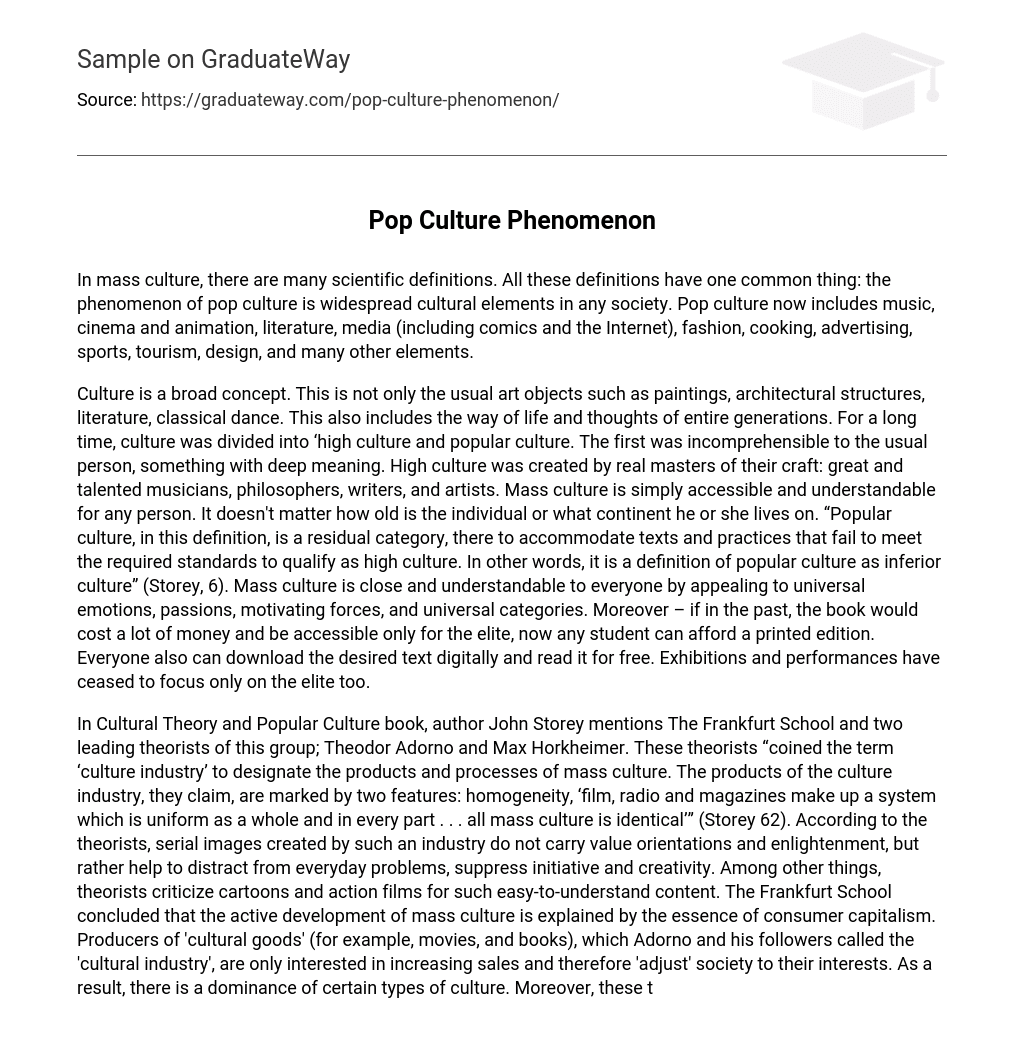In mass culture, there are many scientific definitions. All these definitions have one common thing: the phenomenon of pop culture is widespread cultural elements in any society. Pop culture now includes music, cinema and animation, literature, media (including comics and the Internet), fashion, cooking, advertising, sports, tourism, design, and many other elements.
Culture is a broad concept. This is not only the usual art objects such as paintings, architectural structures, literature, classical dance. This also includes the way of life and thoughts of entire generations. For a long time, culture was divided into ‘high culture and popular culture. The first was incomprehensible to the usual person, something with deep meaning. High culture was created by real masters of their craft: great and talented musicians, philosophers, writers, and artists. Mass culture is simply accessible and understandable for any person. It doesn’t matter how old is the individual or what continent he or she lives on. “Popular culture, in this definition, is a residual category, there to accommodate texts and practices that fail to meet the required standards to qualify as high culture. In other words, it is a definition of popular culture as inferior culture” (Storey, 6). Mass culture is close and understandable to everyone by appealing to universal emotions, passions, motivating forces, and universal categories. Moreover – if in the past, the book would cost a lot of money and be accessible only for the elite, now any student can afford a printed edition. Everyone also can download the desired text digitally and read it for free. Exhibitions and performances have ceased to focus only on the elite too.
In Cultural Theory and Popular Culture book, author John Storey mentions The Frankfurt School and two leading theorists of this group; Theodor Adorno and Max Horkheimer. These theorists “coined the term ‘culture industry’ to designate the products and processes of mass culture. The products of the culture industry, they claim, are marked by two features: homogeneity, ‘film, radio and magazines make up a system which is uniform as a whole and in every part . . . all mass culture is identical’” (Storey 62). According to the theorists, serial images created by such an industry do not carry value orientations and enlightenment, but rather help to distract from everyday problems, suppress initiative and creativity. Among other things, theorists criticize cartoons and action films for such easy-to-understand content. The Frankfurt School concluded that the active development of mass culture is explained by the essence of consumer capitalism. Producers of ‘cultural goods’ (for example, movies, and books), which Adorno and his followers called the ‘cultural industry’, are only interested in increasing sales and therefore ‘adjust’ society to their interests. As a result, there is a dominance of certain types of culture. Moreover, these types of culture are usually of low quality — the fact is that mass production is not interested in single expensive high-quality goods, it requires a lot of cheap goods that are available to most consumers.
However, in our generation, popular culture might be seen not only as a product that the industry presents to the passive ‘masses’ but also as a field for creativity and displaying social processes and changes. For example, popular culture has seen a shift to racial tolerance over the past 50 years. For example, the movie “The Help” in genre drama/historical by Tate Taylor, adaptation of the novel of the same name by Catherine Stockett, reveals the biggest problem in our society – the social inequality. The film depicts a really clear problem and the director showed this problem from the inside that makes every person thinking about this social issue more seriously. About the argument of Frankfurt School that the culture industry is not interested to create decent types of pop culture, it can be said that in the digital era time people spend a lot of money on making good quality books, movies, songs, etc. Unlike the relatively new film The Help, in the 1950s cartoon ‘Tom and Jerry’, an African-American woman is represented only as a servant, whose hands in white gloves occasionally flash in the frame. In this cartoon dark skin woman is depicted as a service class as she is supposed to be only in this class in the society. Besides, mass communication media are becoming more widely used for educational purposes. There are plenty of movies and documentaries that can be entertaining and educational at the same time. Basically, in history there have always been ‘high’ and ‘low’ culture — the first flourished among the educated elite, the second-respectively, among the working class and lower people. However, in recent decades, the boundaries between these cultures have gradually blurred. This is partly because participation in the creation of culture has become much easier than before: for example, anyone can create a page on the media platform such as YouTube or Instagram and put their poems or drawings on it, thus becoming part of the world cultural process. In fact, pop culture has become a way to control the thoughts and feelings of the masses.
Another feature of pop culture is the orientation to create a ‘cult of the star’, as a result of which the consumer begins to follow the values, imitate the behavior models of popular people. One of the current trends in popular culture today is the creation of large-scale and influential media images that become objects of active imitation and worship. They are often stars of cinema, music and other spheres of show business. Media images of celebrities fill a certain intent in the public consciousness: they become the carriers and embodiments of certain ideals, and thus their very existence acquires symbolic significance. These influential images are exploited by the mass media can be described by a more accurate term – media idol.





